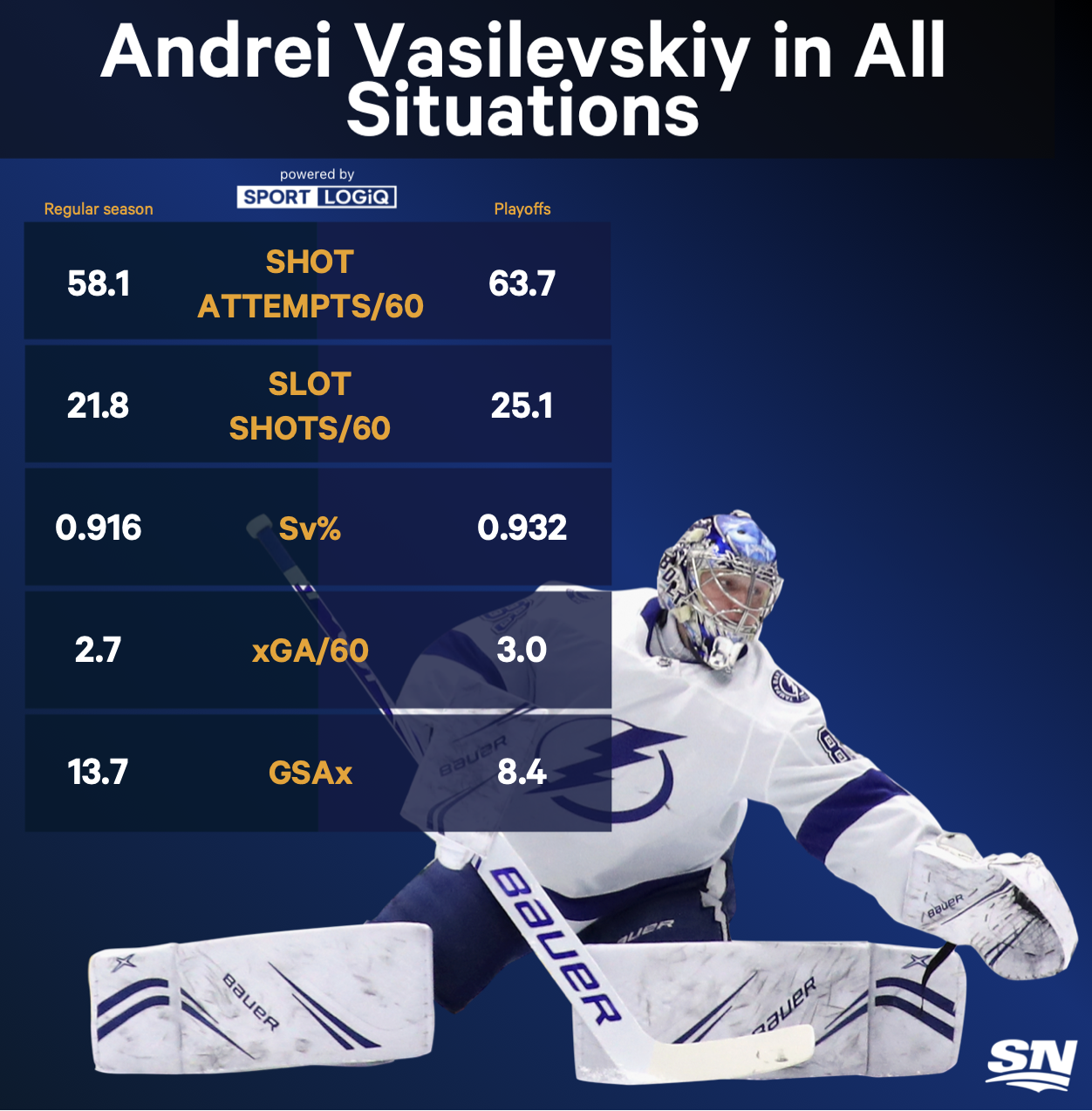Round 3 opened with a bang, with a chaotic game between the Colorado Avalanche and Edmonton Oilers. While the McMatchup featured 14 total goals in Game 1, the Eastern Conference Final is expected to be much different. While there’s some stellar talent in front of the blue paint on both the New York Rangers and Tampa Bay Lightning, this matchup is all about the duel between elite goaltenders.
It’s Igor Shesterkin, the best goalie of the regular season, against Andrei Vasilevskiy, who has backstopped his team to victory the last two years with outstanding play.
Shesterkin’s elite play made him a front-runner for the Vezina this season, and landed him as a Hart Trophy finalist. He led all starters with a .935 save percentage in the regular season. Based on the workload he faced, the Rangers’ netminder saved 41 goals above expected — that’s more than double the next best in the league, Ilya Sorokin’s 19.1.
The Rangers tested their goaltender, making him face a high rate of shot attempts against of 59.9 per 60 in all situations. About 6.4 shots per 60 went on goal from the inner slot area, and it didn’t help that the team infant allowed puck movement to that area of the ice which made scoring chances all the more dangerous.
New York kept Shesterkin busy in the regular season; he faced one of the higher rates of slot attempts off the rush at 5-on-5 with about 6.7 per 60. The scoresheet didn’t reflect that thanks to his outstanding play in goal, however. He faced a slightly higher rate of those quality looks off the cycle (7.0 per 60), but was strong in the crease.
Vasilevskiy ended the regular season with a .916 save percentage and stopped 13.7 goals above expected. While that’s above average, it’s not quite at the heights of seasons past. Last year, for example, he earned a GSAx of 16.4 in 21 fewer games.
In all situations, Vasilevskiy faced a rate of 58.1 shot attempts against per 60 but fewer went on goal from the inner slot than his Round 3 opponent faced. Plus, the Lightning did a better job of limiting those passes to the slot to set up scoring chances.
At 5-on-5, Tampa Bay’s goalie saw a slightly lower rate of slot attempts than Shesterkin — 6.3 attempts off the rush and 6.1 off the cycle. He did, however, allow slightly more goals off those scoring chances.
But that’s the regular season, and the playoffs are a different animal.
No one knows that better than Vasilevskiy who has been there before and thrived there. Just look to the Lightning’s run last year, when he saved 12.3 more goals than expected on his way to the Conn Smyth.

While he wasn’t at that level to start the post-season against Toronto, he was in Game 7 when he saved 1.13 goals above expected to help fuel his team forward. Vasilevskiy kicked his game up a notch in Round 2. Florida’s shot quality equated to 13 expected goals for, but were only able to muster three tallies. That meant the Lightning goalie saved 10 goals above expected through four games, which is an absolute difference maker.
Overall, he boasts a .932 save percentage and GSAx of 8.4 through 11 games so far. Five of those 11 games classify as a quality start, and two wins can be considered steals.

Shesterkin doesn’t have the playoff resume of his next opponent. This is his first NHL playoff experience besides one play-in game in the bubble two seasons back. He started Round 1 with a bang, playing out of his mind against the Pittsburgh Penguins in a lengthy overtime game. But Games 3 and 4 were a challenge in Pittsburgh; he didn’t have any support at all, and didn’t respond well to the workload he faced. For this goalie, it was all about how he finished, as he elevated his game to end the series strong. And he was quite the difference-maker against the Hurricanes in Round 2, with 7.7 goals saved above expected.

Now through 14 games, he’s saved 8.9 goals above expected and is right behind Vasilevskiy with a save percentage of .928. Shesterkin also leads all goalies in the playoffs with seven quality starts with performances that gave his team a chance to win.

This goalie duel adds a ton of intrigue to the Eastern Conference Final. On the one side, there’s the Lightning who know what it takes to win it all and have the scoring talent to support their netminder. However, their road past the Rangers won’t be easy against Shesterkin — especially without Brayden Point in the lineup to help give their goalie offensive support.
The Rangers, on the other hand, are the underdog because of their 5-on-5 offensive generation. This team has shown that they can score, but they’re going to have to find ways to challenge Vasilevskiy with more quality shot generation and can’t rely on finishing talent alone.
Along with offence, there’s obviously defensive considerations.
Tampa Bay has exposed Vasilevskiy to a slightly tougher workload so far in the playoffs compared to the regular season, yet he’s managed it quite well. He’s actually faced a higher rate of shot attempts off the rush at 5-on-5 (7.4 per 60) than Shesterkin (5.9 per 60) in the post-season and has seen a slight uptick in goals against off those scoring chances. Both goalies have been challenged with quality shots off the rush, but Vasilevskiy’s kept more off the scoresheet.
But in all situations, Shesterkin’s been more exposed in the inner slot compared to Vasilevskiy, as the heat maps help show, and the Rangers’ short-handed play factors into that.

Another factor could be puck-handling. Shesterkin’s shown his passing ability throughout the season, and that can help the Rangers breakout quicker if they’re stuck in their own zone. Tampa Bay’s the better team when it comes to controlled exits at 5-on-5, while New York’s had many of shifts where they find themselves hemmed in their own zone. But a confident goaltender who can move the puck to spark exit attempts could be an advantage here as well.
The Eastern Conference Final projects to be a much different series from the West. It’s a best-on-best of two elite goaltenders who very well could be the difference maker in this series. But this is also a test for the teams in front of the blue paint: who will defend the quality areas better to ease their workloads? Who will generate more offense to test their opponent more?
That’s what may be what sets these teams apart and determines who moves on to the Stanley Cup Final.
Data via Sportlogiq






